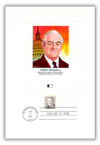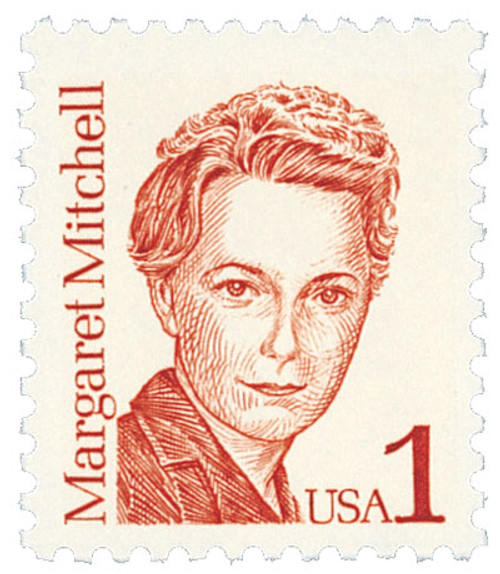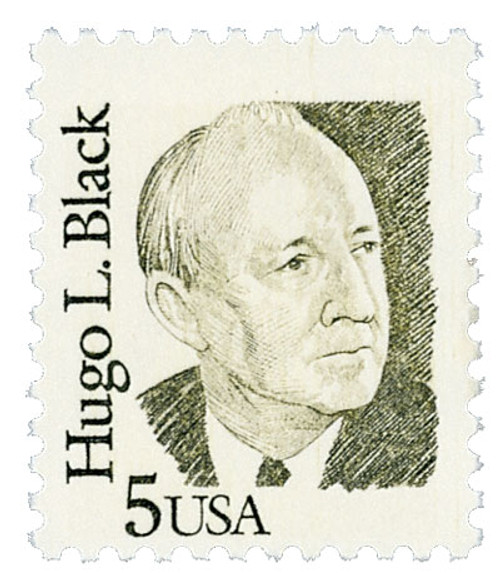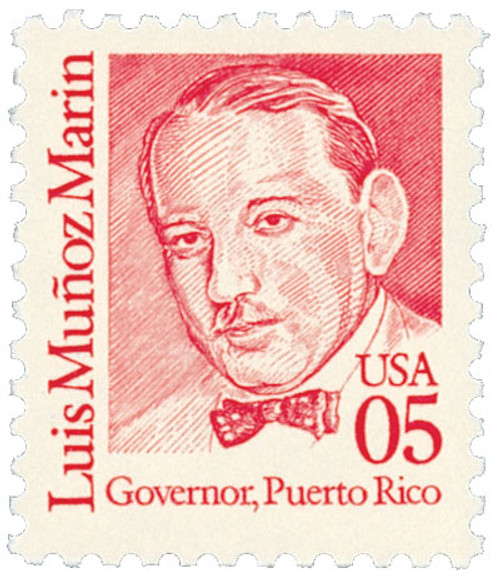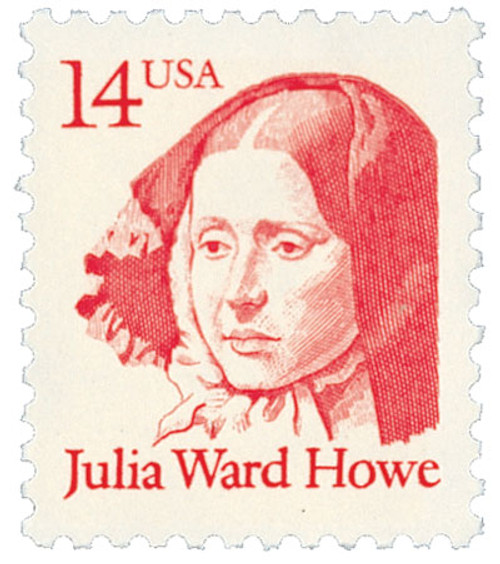
# 2189 FDC - 1991 52c Great Americans: Hubert H. Humphrey
U.S. #2189
1991 52¢ Hubert H. Humphrey
Great Americans
- Honors America’s 38th vice president
- A factual error in the selvage nearly led to a costly $580,000 reprint!
- Paid the two-ounce letter rate
Stamp Category: Definitive
Series: Great Americans
Value: 52¢, paid the two-ounce letter rate
First Day of Issue: June 3, 1991
First Day City: Minneapolis, Minnesota
Quantity Issued: 242,020,000
Printed by: Bureau of Engraving and Printing
Printing Method: Engraved
Format: Panes of 100 in sheets of 800
Perforations: 11.2
Color: Purple
Why the stamp was issued: This stamp paid the two-ounce letter rate that went into effect on February 3, 1991.
About the stamp design: Minnesota artist John C. Berkey was hired to provide the artwork for this stamp. He reached out to Humphrey’s son, who sent him a 1964 photo taken by Kurt F.G. Jafay. Berkey produced his artwork in pencil.
First Day City: The First Day ceremony for this stamp was held at the Hubert H. Humphrey Institute on the University of Minnesota campus in Minneapolis.
Unusual fact about this stamp: The selvage for this stamp has a mistake – it reads “From 1964 to 1968, he served as the 38th vice president.” While he and his running mate Lyndon Johnson were elected in 1964, they didn’t take office until January 1965, and they left the white house in January 1969. On April 12, Linn’s Stamp News discovered the error and reached out to the USPS, which was unaware of it up to that point. They said that the years were meant to include when he was elected, and that the stamp would be issued as it was.
Linn’s ran a story on the error on April 17, which was picked up by The Washington Post on April 23. The Washington Post speculated that the stamps might be destroyed and reprinting. Later that same day, the USPS announced that they would correct and reprint the stamps “to maintain the integrity of the stamp program and to ensure the historical accuracy of the selvage text.” The reprint would cost $580,000. However, when Minnesota congressman Gerry Sikorski of the House Post Office and Civil Service Committee learned of the plans, he wrote to the postmaster general strongly suggesting they reconsider. On April 24, the USPS announced that the reprint was canceled and the stamps would be issued as printed.
The USPS reasoned that, since most people discard the selvage, and the error wasn’t in the actual stamp design, it wasn’t worth the high cost to reprint. The selvage was corrected for future printings, #2189a.
About the Great Americans Series: The Great Americans Series was created to replace the Americana Series. The new series would be characterized by a standard definitive size, simple design, and monochromatic colors.
This simple design included a portrait, “USA,” the denomination, the person’s name, and in some cases, their occupation or reason for recognition. The first stamp in the new series was issued on December 27, 1980. It honored Sequoyah and fulfilled the new international postcard rate that would go into effect in January 1981.
The Great Americans Series would honor a wider range of people than the previous Prominent Americans and Liberty Series. While those series mainly honored presidents and politicians, the Great Americans Series featured people from many fields and ethnicities. They were individuals who were leaders in education, the military, literature, the arts, and human and civil rights. Plus, while the previous series only honored a few women, the Great Americans featured 15 women. This was also the first definitive series to honor Native Americans, with five stamps.
The Bureau of Engraving and Printing (BEP) produced most of the stamps, but private firms printed some. Several stamps saw multiple printings. The result was many different varieties, with tagging being the key to understanding them. Though there were also differences in perforations, gum, paper, and ink color.
The final stamp in the series was issued on July 17, 1999, honoring Justin S. Morrill. Spanning 20 years, the Great Americans was the longest-running US definitive series. It was also the largest series of face-different stamps, with a total of 63.
Click here for all the individual stamps and click here for the complete series.
History the stamp represents: Hubert Horatio Humphrey Jr. was born on May 27, 1911, in Wallace, South Dakota. He was a leading political figure in the mid-1900s, promoting the Civil Rights Act, Voting Rights Act, and more.
Humphrey’s father was a pharmacist who at times was also mayor and member of the town council and state legislature. Humphrey attended the University of Minnesota for one year, but had to leave because of the family’s financial struggles. He earned his pharmacist’s license and helped his father run his drugstore from 1931 to 1937. He and his father also developed a wide range of products for humans and hogs, which made them the go-to pharmacy for many farmers.
Humphrey longed to return to school to study political science and become a college professor. When the family store was once again successful, he left to resume his studies at the University of Minnesota. Humphrey then earned his master’s degree at Louisiana State University. He worked for the Work Projects Administration, established as part of President Franklin D. Roosevelt’s “New Deal,” and for the War Manpower Commission in Minneapolis, Minnesota. Humphrey also taught political science at Macalester College in St. Paul, Minnesota. He tried to enlist three times during World War II, but was repeatedly rejected for colorblindness and other health issues.
Humphrey’s political career began on an unsuccessful note when he failed to win election as the mayor of Minneapolis, Minnesota, in 1943. Humphrey continued to work in politics, and in 1945, he reached that office. He was re-elected in 1947. His prominence in national politics began at the 1948 Democratic Convention, when he led the party to take a strong stand on civil rights, urging the party “to get out of the shadow of states’ rights and walk forthrightly into the bright sunshine of human rights.”
In 1948, the people of Minnesota elected Humphrey to his first term in the US Senate. He was young, eager, outspoken, and calling for reform, which earned him few friends early on. But Humphrey was dedicated to issues such as civil rights, labor, and education, and sponsored over 1,000 bills and joint resolutions during his first two terms in the Senate alone.
Humphrey became the Senate Democratic whip (assistant leader) in 1961. He fought for arms control, civil rights, medical benefits for the poor, and support of education. He was instrumental in the passage of the 1963 Limited Nuclear Test Ban Treaty and the 1964 Civil Rights Act.
In 1964, President Lyndon Johnson selected Humphrey as his running mate in the presidential election. Johnson’s bid was successful, and Humphrey resigned from the Senate to begin his term as vice president in 1965. Initially, he actively promoted the administration’s agenda and helped secure the passage of important legislation, including the Voting Rights Act of 1965. However, Johnson’s Great Society program began to lose support and Humphrey questioned some of Johnson’s policies in Vietnam, leading the vice president to be shut out of many high-level meetings. But Humphrey remained busy, promoting the administration’s Vietnam policies, which disappointed many of his own supporters. He also traveled more than any vice president before him – 12 trips outside the US to 31 countries.
When Johnson decided not to run for another term in 1968, Humphrey received the Democratic party’s nomination for president. However, he was defeated by former Vice President Richard Nixon by less than 1% of the popular vote. Although he campaigned for the nomination, Humphrey was not selected as a Democratic candidate for the 1972 election.
Humphrey was again elected to the Senate in 1970 and 1976. In 1977, the Senate appointed him deputy president pro tempore of the Senate. The position was newly created, with the resolution stating that and former president or vice president serving in the Senate would be entitled to the position. The role was largely ceremonial, but did come with a salary increase equal to that of the president pro tempore and the majority and minority leaders. Known as the “Happy Warrior,” Humphrey continued his loyal public service as a leading senator even after he was diagnosed as terminally ill and in great physical pain. He died while still in office on January 13, 1978. Humphrey was posthumously awarded the Congressional Gold Medal and the Presidential Medal of Freedom. Today there are several schools, buildings, and other places named in his honor.
U.S. #2189
1991 52¢ Hubert H. Humphrey
Great Americans
- Honors America’s 38th vice president
- A factual error in the selvage nearly led to a costly $580,000 reprint!
- Paid the two-ounce letter rate
Stamp Category: Definitive
Series: Great Americans
Value: 52¢, paid the two-ounce letter rate
First Day of Issue: June 3, 1991
First Day City: Minneapolis, Minnesota
Quantity Issued: 242,020,000
Printed by: Bureau of Engraving and Printing
Printing Method: Engraved
Format: Panes of 100 in sheets of 800
Perforations: 11.2
Color: Purple
Why the stamp was issued: This stamp paid the two-ounce letter rate that went into effect on February 3, 1991.
About the stamp design: Minnesota artist John C. Berkey was hired to provide the artwork for this stamp. He reached out to Humphrey’s son, who sent him a 1964 photo taken by Kurt F.G. Jafay. Berkey produced his artwork in pencil.
First Day City: The First Day ceremony for this stamp was held at the Hubert H. Humphrey Institute on the University of Minnesota campus in Minneapolis.
Unusual fact about this stamp: The selvage for this stamp has a mistake – it reads “From 1964 to 1968, he served as the 38th vice president.” While he and his running mate Lyndon Johnson were elected in 1964, they didn’t take office until January 1965, and they left the white house in January 1969. On April 12, Linn’s Stamp News discovered the error and reached out to the USPS, which was unaware of it up to that point. They said that the years were meant to include when he was elected, and that the stamp would be issued as it was.
Linn’s ran a story on the error on April 17, which was picked up by The Washington Post on April 23. The Washington Post speculated that the stamps might be destroyed and reprinting. Later that same day, the USPS announced that they would correct and reprint the stamps “to maintain the integrity of the stamp program and to ensure the historical accuracy of the selvage text.” The reprint would cost $580,000. However, when Minnesota congressman Gerry Sikorski of the House Post Office and Civil Service Committee learned of the plans, he wrote to the postmaster general strongly suggesting they reconsider. On April 24, the USPS announced that the reprint was canceled and the stamps would be issued as printed.
The USPS reasoned that, since most people discard the selvage, and the error wasn’t in the actual stamp design, it wasn’t worth the high cost to reprint. The selvage was corrected for future printings, #2189a.
About the Great Americans Series: The Great Americans Series was created to replace the Americana Series. The new series would be characterized by a standard definitive size, simple design, and monochromatic colors.
This simple design included a portrait, “USA,” the denomination, the person’s name, and in some cases, their occupation or reason for recognition. The first stamp in the new series was issued on December 27, 1980. It honored Sequoyah and fulfilled the new international postcard rate that would go into effect in January 1981.
The Great Americans Series would honor a wider range of people than the previous Prominent Americans and Liberty Series. While those series mainly honored presidents and politicians, the Great Americans Series featured people from many fields and ethnicities. They were individuals who were leaders in education, the military, literature, the arts, and human and civil rights. Plus, while the previous series only honored a few women, the Great Americans featured 15 women. This was also the first definitive series to honor Native Americans, with five stamps.
The Bureau of Engraving and Printing (BEP) produced most of the stamps, but private firms printed some. Several stamps saw multiple printings. The result was many different varieties, with tagging being the key to understanding them. Though there were also differences in perforations, gum, paper, and ink color.
The final stamp in the series was issued on July 17, 1999, honoring Justin S. Morrill. Spanning 20 years, the Great Americans was the longest-running US definitive series. It was also the largest series of face-different stamps, with a total of 63.
Click here for all the individual stamps and click here for the complete series.
History the stamp represents: Hubert Horatio Humphrey Jr. was born on May 27, 1911, in Wallace, South Dakota. He was a leading political figure in the mid-1900s, promoting the Civil Rights Act, Voting Rights Act, and more.
Humphrey’s father was a pharmacist who at times was also mayor and member of the town council and state legislature. Humphrey attended the University of Minnesota for one year, but had to leave because of the family’s financial struggles. He earned his pharmacist’s license and helped his father run his drugstore from 1931 to 1937. He and his father also developed a wide range of products for humans and hogs, which made them the go-to pharmacy for many farmers.
Humphrey longed to return to school to study political science and become a college professor. When the family store was once again successful, he left to resume his studies at the University of Minnesota. Humphrey then earned his master’s degree at Louisiana State University. He worked for the Work Projects Administration, established as part of President Franklin D. Roosevelt’s “New Deal,” and for the War Manpower Commission in Minneapolis, Minnesota. Humphrey also taught political science at Macalester College in St. Paul, Minnesota. He tried to enlist three times during World War II, but was repeatedly rejected for colorblindness and other health issues.
Humphrey’s political career began on an unsuccessful note when he failed to win election as the mayor of Minneapolis, Minnesota, in 1943. Humphrey continued to work in politics, and in 1945, he reached that office. He was re-elected in 1947. His prominence in national politics began at the 1948 Democratic Convention, when he led the party to take a strong stand on civil rights, urging the party “to get out of the shadow of states’ rights and walk forthrightly into the bright sunshine of human rights.”
In 1948, the people of Minnesota elected Humphrey to his first term in the US Senate. He was young, eager, outspoken, and calling for reform, which earned him few friends early on. But Humphrey was dedicated to issues such as civil rights, labor, and education, and sponsored over 1,000 bills and joint resolutions during his first two terms in the Senate alone.
Humphrey became the Senate Democratic whip (assistant leader) in 1961. He fought for arms control, civil rights, medical benefits for the poor, and support of education. He was instrumental in the passage of the 1963 Limited Nuclear Test Ban Treaty and the 1964 Civil Rights Act.
In 1964, President Lyndon Johnson selected Humphrey as his running mate in the presidential election. Johnson’s bid was successful, and Humphrey resigned from the Senate to begin his term as vice president in 1965. Initially, he actively promoted the administration’s agenda and helped secure the passage of important legislation, including the Voting Rights Act of 1965. However, Johnson’s Great Society program began to lose support and Humphrey questioned some of Johnson’s policies in Vietnam, leading the vice president to be shut out of many high-level meetings. But Humphrey remained busy, promoting the administration’s Vietnam policies, which disappointed many of his own supporters. He also traveled more than any vice president before him – 12 trips outside the US to 31 countries.
When Johnson decided not to run for another term in 1968, Humphrey received the Democratic party’s nomination for president. However, he was defeated by former Vice President Richard Nixon by less than 1% of the popular vote. Although he campaigned for the nomination, Humphrey was not selected as a Democratic candidate for the 1972 election.
Humphrey was again elected to the Senate in 1970 and 1976. In 1977, the Senate appointed him deputy president pro tempore of the Senate. The position was newly created, with the resolution stating that and former president or vice president serving in the Senate would be entitled to the position. The role was largely ceremonial, but did come with a salary increase equal to that of the president pro tempore and the majority and minority leaders. Known as the “Happy Warrior,” Humphrey continued his loyal public service as a leading senator even after he was diagnosed as terminally ill and in great physical pain. He died while still in office on January 13, 1978. Humphrey was posthumously awarded the Congressional Gold Medal and the Presidential Medal of Freedom. Today there are several schools, buildings, and other places named in his honor.





